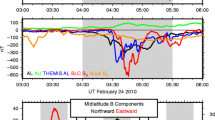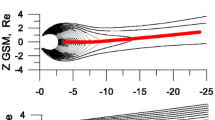Abstract
We investigate the large-scale substorm current systems developed from its onset in an idealized substorm event simulated by global magnetohydrodynamic (MHD) models. Mainly three current systems (loops) are revealed: (1) the classical substorm current wedge, which is composed by the disputed cross-tail current in the magnetotail, the nightside westward electrojet in the high-latitude ionosphere and a pair of region 1 field-aligned currents (FAC); (2) the partial-ring current system, which is braced by two region 2 FACs; and (3) the meridional current system, which is formed by an equatorial radial current (outward/inward in the morning/evening sector), and region 1 and region 2 FACs at its two ends. The region 2 FAC connects with region 1 FAC by a latitudinal horizontal current at each morning/evening ionosphere to complete Loops 2 and 3. A quantitative study shows the significant enhancement of these current systems during the substorm expansion phase, while Loop 1 dominates, which can reach a magnitude of ~1 MA. Empirical relations among the ionospheric currents and the related magnetotail currents are established based on the simulation results, implying that the substorm current systems are not evolved locally or separately, but must be viewed from a global perspective. This knowledge of large-scale substorm current system would deepen our understanding of the substorm development and could be validated by observations in the future.
Similar content being viewed by others
References
McPherron R L, Russell C T, Aubry M P. Satellite studies of magnetospheric substorms on August 15, 1968: 9. Phenomenological model for substorms. J Geophys Res, 1973, 78: 3131–3149
Sergeev V A, Tsyganenko N A, Smirnov M V, et al. Magnetic effects of the substorm current wedge in a “spread-out wire model and their comparison with ground, geosynchronous, and tail lobe data. J Geophys Res, 2011, 116: A07218
Sergeev V A, Nikolaev A V, Tsyganenko N A, et al. Testing a two-loop pattern of the substorm current wedge (SCW2L). J Geophys Res Space Phys, 2014, 119: 947–963
Yang J, Toffoletto F R, Wolf R A, et al. Large-scale current systems and ground magnetic disturbance during deep substorm injections. J Geophys Res, 2012, 117: A04223
Liu J, Angelopoulos V, Runov A, et al. On the current sheets surrounding dipolarizing flux bundles in the magnetotail: The case for wedgelets. J Geophys Res Space Phys, 2013, 118: 2000–2020
Sun W J, Fu S Y, Parks G K, et al. Field-aligned currents associated with dipolarization fronts. Geophys Res Lett, 2013, 40: 4503–4508
Yu Y, Cao J, Fu H, et al. The effects of bursty bulk flows on global-scale current systems. J Geophys Res Space Phys, 2017, 122: 6139–6149
Birn J, Hesse M, Haerendel G, et al. Flow braking and the substorm current wedge. J Geophys Res, 1999, 104: 19895–19903
Birn J, Hesse M. The substorm current wedge: Further insights from MHD simulations. J Geophys Res Space Phys, 2014, 119: 3503–3513
Iijima T, Potemra T A, Zanetti L J. Large-scale characteristics of magnetospheric equatorial currents. J Geophys Res, 1990, 95: 991–999
Bostr¨om R. A model of the auroral electrojects. J Geophys Res, 1964, 69: 4983–4999
Shiokawa K, Haerendel G, Baumjohann W. Azimuthal pressure gradient as driving force of substorm currents. Geophys Res Lett, 1998, 25: 959–962
Lui A T Y, Kamide Y. A fresh perspective of the substorm current system and its dynamo. Geophys Res Lett, 2003, 30: 1958
Iijima T, Potemra T A. Large-scale characteristics of field-aligned currents associated with substorms. J Geophys Res, 1978, 83: 599–615
Coxon J C, Milan S E, Clausen L B N, et al. A superposed epoch analysis of the regions 1 and 2 Birkeland currents observed by AMPERE during substorms. J Geophys Res Space Phys, 2014, 119: 9834–9846
Kamide Y, Sun W, Akasofu S I. The average ionospheric electrodynamics for the different substorm phases. J Geophys Res, 1996, 101: 99–109
Tang B B, Wang C, Hu Y Q, et al. Intensification of the Cowling current in the global MHD simulation model. J Geophys Res, 2011, 116: A06204
Cowley S W H. Magnetosphere-ionosphere interactions: A tutorial review. In: Ohtani S-I, Fujii R, Hesse M, et al., eds. Magnetospheric Current Systems. Washington DC: American Geophysical Union, 2000. 91–106
Kepko L, McPherron R L, Amm O, et al. Substorm Current Wedge Revisited. Space Sci Rev, 2015, 190: 1–46
Hu Y Q, Guo X C, Wang C. On the ionospheric and reconnection potentials of the earth: Results from global MHD simulations. J Geophys Res, 2007, 112: A07215
Wang C, Guo X C, Peng Z, et al. Magnetohydrodynamics (MHD) numerical simulations on the interaction of the solar wind with the magnetosphere: A review. Sci China Earth Sci, 2013, 56: 1141–1157
Lester M, Davies J A, Virdi T S. High-latitude Hall and Pedersen conductances during substorm activity in the SUNDIAL-ATLAS campaign. J Geophys Res, 1996, 101: 26719–26728
Miyashita Y, Machida S, Kamide Y, et al. A state-of-the-art picture of substorm-associated evolution of the near-Earth magnetotail obtained from superposed epoch analysis. J Geophys Res, 2009, 114: A01211
**ng X, Lyons L R, Angelopoulos V, et al. Plasma sheet pressure evolution related to substorms. J Geophys Res, 2010, 115: A01212
Ahn B H, Richmond A D, Kamide Y, et al. An ionospheric conductance model based on ground magnetic disturbance data. J Geophys Res, 1998, 103: 14769–14780
Raeder J, McPherron R L, Frank L A, et al. Global simulation of the Geospace EnvironmentModeling substorm challenge event. J Geophys Res, 2001, 106: 381–395
Liu J, Angelopoulos V, Chu X, et al. Substorm current wedge composition by wedgelets. Geophys Res Lett, 2015, 42: 1669–1676
Guo X C, Wang C, Hu Y Q, et al. Bow shock contributions to region 1 field-aligned current: A new result from global MHD simulations. Geophys Res Lett, 2008, 35: L03108
Yu Y, Jordanova V K, Ridley A J, et al. A new ionospheric electron precipitation module coupled with RAM-SCB within the geospace general circulation model. J Geophys Res Space Phys, 2016, 121: 8554–8575
Author information
Authors and Affiliations
Corresponding author
Rights and permissions
About this article
Cite this article
Tang, B., Wang, C. Large scale current systems developed from substorm onset: Global MHD results. Sci. China Technol. Sci. 61, 389–396 (2018). https://doi.org/10.1007/s11431-017-9132-y
Received:
Accepted:
Published:
Issue Date:
DOI: https://doi.org/10.1007/s11431-017-9132-y




